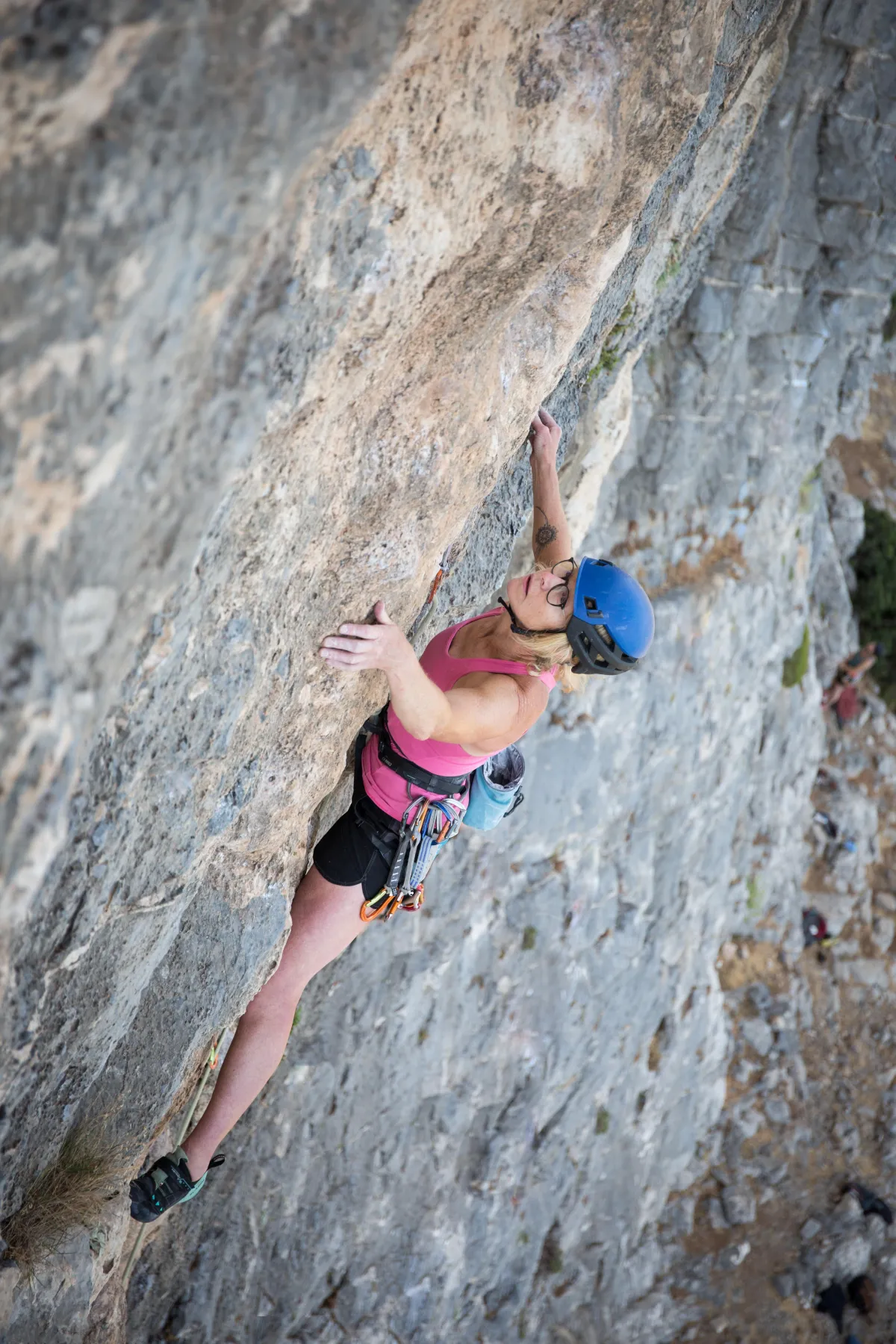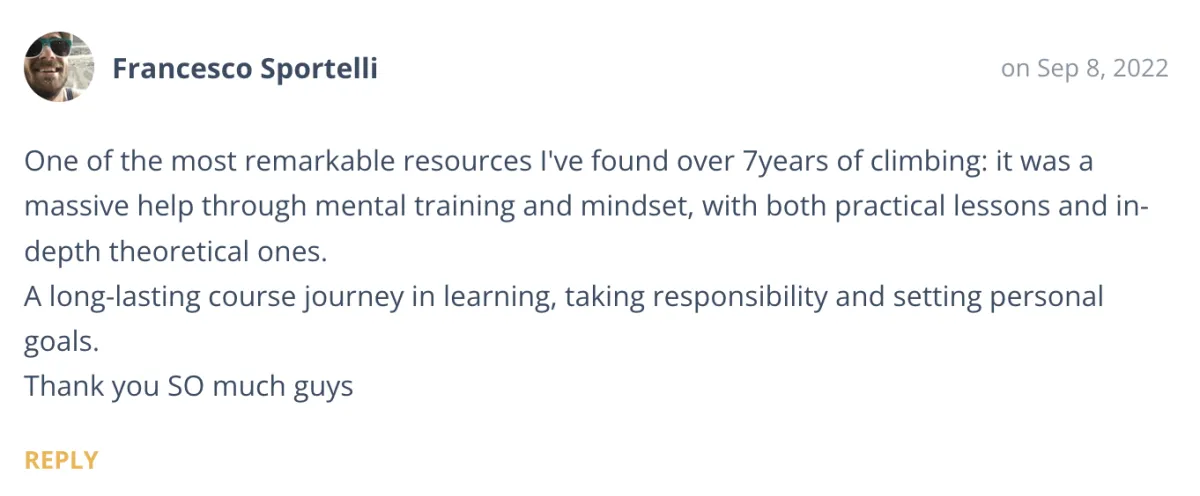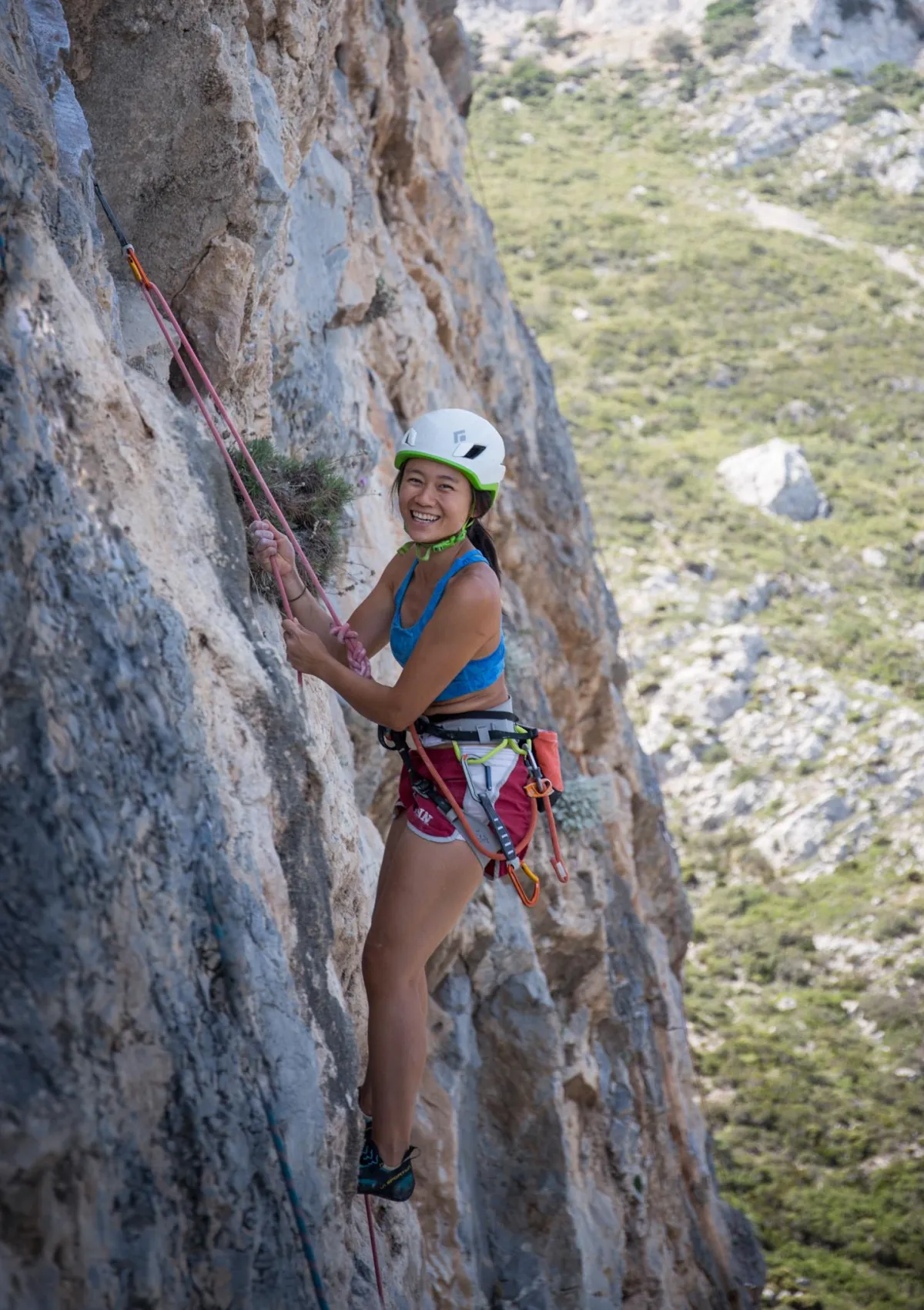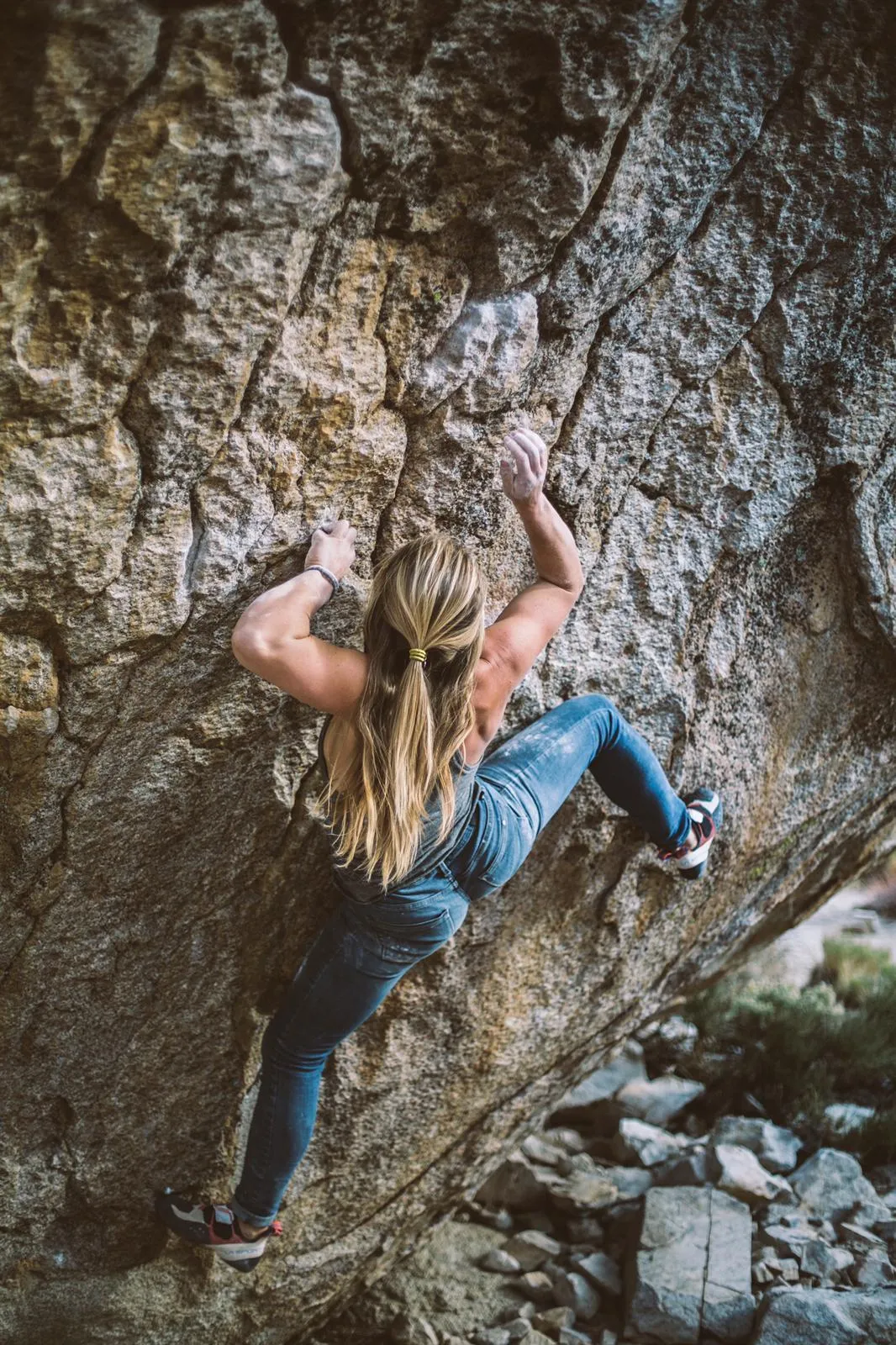
2 years access to the content
6 weeks of support
Top-rope, sport, trad and bouldering
3 course instructors
Community support and live Q&As
Enrollment Is Now Open!
Want To Climb Harder Without Fear Or Tension Holding You Back?
Join the Strong Mind Program to break through your plateaus, climb harder and stop letting fear define your climbing experience.
We're currently accepting students for the 2024 Strong Mind cohort. Click here to sign up.
For most of us, the psychological challenge is part of what brought us to climbing in the first place.
But so many climbers work on getting stronger and fitter, only to over-grip on their projects.
The truth is:
Fear holds more people back than finger strength.
A lot of climbers make progress fast, but after a certain point their climbing plateaus or even gets worse.
This is because they are not addressing their fear and stress levels, which eventually leads to an avoidant or anxious climbing style.
At this point, just focusing on physical training means ignoring the bigger, more important and more interesting challenge in climbing.
Our common intuitions don’t serve us well when it comes to fear management, so climbers that work on their fears on their own often end up making things worse.
But with structured mental training you can unlock your potential as a climber – your psychology could be one of your strengths in climbing, rather than something that holds you back.
Who Flight School Is For:
Let me ask you some questions:
Are you mostly thinking about getting to the next bolt when you climb?
Do you avoid falling and often say ‘take’ if you need to rest?
Do you avoid hard moves at the top of the bouldering wall?
Do you lower your grade to avoid falling and as a result fail to progress very quickly?
Does your body tension or anxiety increase as you get further away from the bolt, protection, or mat?
Do you breathe a sigh of relief every time you clip the bolt or get a piece in even though it's safe to fall?
What happens if you continue as you are and you carry your fear of falling up every climb?
What opportunities, dream climbs and amazing experiences are you missing out on because you avoid falling or feel tense when you climb?
How much quicker would you improve as a climber if you could relax on the wall?
Learning to manage fear of falling is the single most effective way to become a better climber.
This Is Why Every Climber, At Some Point, Should Focus On Mental Training
Mental training is the low-hanging fruit of not just performance, but enjoyment in climbing.
With mental training around fear management, you'll enjoy climbing more because you'll be less stressed, tense and anxious.
Instead of avoiding fear or blindly pushing through it, you'll be in tune with your body and build self-awareness as a climber.
As a result, you'll hesitate less and trust your body to just go for it. You'll be able to climb harder and try climbs that genuinely inspire you.
You won't avoid routes that you know you might fail on, and you won't climb harder on top rope compared to on lead.
Wouldn't it be nice to be able to walk up to any climb or boulder problem that looked cool and give it a go?
No amount of physical training will get you to that point. Only when you add in mental training, you can unlock your full potential as a climber.
I've seen it over and over again in students that have taken our courses in the past.
Most climbers don't train their minds because they don't think they can.
This isn't true, and we've got hundreds (if not thousands) of climbers that can prove it.
Here Are Some Examples Of How Mental Training Can Help You Break Through Your Plateaus, Fast.


"I was a climber who never fell, I was a climber who avoided falling and therefore routes I might fall off! I started Strong Mind's course in winter and by spring was beginning fall practice outdoors. Fast forward 8 months and I am falling off much more and importantly, happily, and now starting to try routes that I know I will fall off. I have also led my first 7a. I definitely could not have made this progress without this amazing course and incredible instructors."
Helen Burgess (lead her first 7a at 50 years old after doing the course)
"Over the last few months it has been incredibly interesting to watch my mental state evolve, and my climbing evolve with it! In addition to my observations, my climbing partners have all commented how I'm moving easier and taking falls as/ when needed.
I cannot recommend highly enough. Like most climbers I overemphasized the physical and brushed off the mental aspects. If you feel the mental parts might be the limiting factors that are holding you back (spoiler alert: they probably are), this is the course for you!"
Craig Weich
"Every bit of content from Strong Mind has helped and inspired my climbing and applies to other areas of my life as well. Thank you Hazel, Angus and team for creating everything you do and making it so accessible and relatable. They are masters at expressing the inner workings of experience, and influences of the mind as it shows up in climbing in a way that lands. My enjoyment, self empowerment and performance has grown exponentially thanks to Strong Mind. No matter your level or experience, what they offer can help you too."
Nicole Millsaps
Helen had been climbing for 20 years before she learnt to fall. After starting fall training she was able to climb her first 7a at age 50.
Grades aside, the main thing is that she is enjoying climbing more than ever and learning to fall has completely transformed her relationship with climbing. And she isn't alone.
"I have been trying for years to get over my fear of leading and I actually had FUN and felt so free doing it." Elizabeth


Working on fear of falling is helping climbers achieve their goals and enjoy climbing more than ever

These are just a few of the many testimonials we received from people who we've helped manage their fear of falling.
Now does that mean you will get the same results?
That depends...
The Disclaimer That Couldn't Be Any Plainer
There is no trick that will magic away your fear in climbing.
Just like you can't read a book on physical training and expect to get stronger, you can't do this course and get rid of fear without putting in any work. We can guide you but you have to work hard and do the practice. Like anything you get out what you put in.
We also can't be there to make sure you're safe, so you need to take responsibility for your own physical and psychological safety when carrying out any of the exercises that we discuss in this course. Not all the exercises in this course are appropriate for everyone – e.g. we have instructions on trad fall practice that are only appropriate for competent trad climbers.
We'll never ask you to do something you're not comfortable with. This course is about empowering you with the knowledge and teaching you the skills that will enable you to make better decisions around managing your fear in climbing whether you're a boulderer, sport climber, indoor top-rope climber or trad climber.

Here's What We Can Guarantee
We're giving you every tool, tactic, practice and strategy that we personally use in our own climbing and teach others.
Everything we teach is evidence-based and tried and tested on thousands of students that we've worked with.
Now you might be wondering exactly what you're getting:
Exactly What You're Getting

Chapter #1
Mindset
What is 'mindset' and what are different types of mindset
What your current mindset looks like
How you can shift your mindset to get better results from this course and in fear management
Homework tasks
With the right mindset, let's build some knowledge about how to unlearn fear...

Chapter #2
Knowledge and Understanding
The science of fear and stress
Why self-awareness is necessary for fear management to be successful
How to build self-awareness
How to get the psychological challenge level right
The stretch zone model as a means to manage exposure therapy
Eustress and distress
Homework tasks
Now you have the foundations, theory and necessary skills we can start practising!

Chapter #3
Fear of falling, injury, heights and exposure
What is fear of falling – the nuances
A discussion on risk and how to better manage it
Basic instructions and theory for fall practice
Detailed video fall practice instructions for lead, top rope, bouldering and trad climbing
Belaying – How to give soft catches
Safety checklist
Example sample sessions for fall practice
How to analyse your own fall practice videos
Advanced fall practice progressions
Transferring your fall practice to climbing 'in the wild'
Advanced falling practices and nuances
How to motivate for fall practice
Reappraising falling
Climbing partners, teaching and Supporting others with fear
Fear of heights and exposure
Managing bad experiences, accidents and injury
Now let's look at other fears in climbing

Chapter #4
Fear of failure, performance anxiety and social fears
What is fear of failure
How to overcome fear of failure
How to set goals in a way that mitigates fear of failure
How to manage social fears
Self-worth
Self-doubt
Identity issues
Imposter Syndrome
Motivation
Learn how to manage fear and stress in the moment so you can focus on climbing

Chapter #5
Mind Tools
Anchoring tools
Breathing tools
How to focus in the moment while climbing
Tools for managing negative thoughts
How to use mind tools in situations where it is not safe to fall
Resetting, mantras and gratitude tools
Visualisation
Rituals
Let's bring everything together and see what continued practice looks like

Chapter #6
Maintenance and Troubleshooting
Habits and systems
Personal well-being
Fear and the menstrual cycle
Troubleshooting
Transferring your knowledge to other areas of your life
This might look like a lot of content to help you manage your fear in climbing, but everything we teach is necessary if you really want to fear to stop holding you back.
When we put together this course, we really wanted to go above and beyond and make sure you get the help and support you need.
This is why you're also getting live support along with the course.
Here are 6 bonuses worth $870 that we've added for you

FREE BONUS #1
Access to our private virtual community
(Value: $160)
Ask our course instructors questions
Interact with other members of the community
Get plugged into a community of like-minded climbers who accept that falling is normal but that they want to do something about it
Community challenges to help you stay accountable and motivated
Find fall practice buddies with climbers who might be in your local area

FREE BONUS #2
Live Meet-Ups & Q&A Sessions
(Value: $210)
Attend a Q&A every week to ask questions, clarify learning and connect with fellow students
Accessible recordings if you can't make it
Held multiple times throughout the week, morning and evening European time to cover different time zones and schedules
An open live room you can use to chat to your fellow students at any time

FREE BONUS #3
Lifetime Access and Course Updates
(Value: $240)
Benefit to access to the course for as long as we're a company (that's our lifetime, but we hope it's as long as your lifetime too!)
Benefit from updates to course content and what we learn from new research
Get access to new lessons when we release them
We're committed to being the best we can be, so we're constantly challenging ourselves and updating our content

FREE BONUS #4
Strong Mind After Care Sessions
(Value: $60)
At the end of the course we'll hold a live session on 'What's next in your mental training journey'
2 months after the end date of the course we'll hold a live session to check in and see how you're getting on

FREE BONUS #5
Send Us Videos Of You Falling for Analysis
(Value: $150)
Film yourself falling (can just be from the ground with a phone)
Use the video analysis lesson to analyse your fall yourself
Send us your video in the community for us to analyse as well
This helps you build self-awareness and corrects for any gaps in your self-awareness in order to get the challenge level right

FREE BONUS #6
Program Workbook
(Value: $50)
We created a downloadable Workbook to assist and track your learning (this was a major request by our students and something new to this course)
Print and fill by hand or fill in digitally
Write chapter notes, key takaways and track habits
Space to answer reflective questions
Journal prompts
Falling log
That's a lot of free bonuses.
And we've added them to make sure you have every chance of being successful.
This year's Strong Mind Program includes more support than any other course or program we've done in prior years. We have taken feedback from 1000s of students from across our courses to create the most effective learning experience.
You won't be left to figure things out on your own. We're here to help you every step along the way. If that sounds like what you're looking for, let me explain how to secure your spot in the program.
Here's What To Do Next
You can join the Strong Mind Program for $547 one-time or you can hop on board for 6 monthly instalments of $107.
But the way I see it, this program is not an expense, it's an investment in your climbing experience.
Few other interventions will have as big of an impact on your climbing as mental training will have. And no other kinds of training will benefit other areas of your life in such a powerful way.
If you want to join the Strong Mind Program, and join this year's cohort, click on the button below and secure your place before the program is full.
Here's What Happens After That
As soon as you've signed up for the Strong Mind Program, you'll get access to our private virtual community where you can introduce yourself and start making friends.
You'll also receive your login information to access the course content, a welcome email and your receipt (make sure you check your promotions folder and look for these 3 emails).
You'll be plugged into a community of fellow climbers who are all progressing and using mental training to become better climbers.
We'll stay in constant communication in our private Community area where you can share experiences, ask questions and make connections.
Here's how the program breaks down:
Every week you'll get access to a new lessons. You can learn through desktop or through the Kajabi app or you can download audio versions of the lessons onto your phone.
In total you get access to over 11 hours of video training with text, video and audio learning options as well as homework tasks, reflective questions and PDF instructions.
But don't worry, it's easy stuff and everything is delivered in small bite-sized chunks.
You can also participate in our community challenges to make sure you stay accountable to your goals.
If you want to join the Strong Mind Program, and join this year's cohort, click on the button below and secure your place before the program is full.
WARNING!
PLACES ARE LIMITED!
In order to provide you with the support you need in order to get the results you want, we need to limit the number of students in the program.
We want to make sure that we can answer everyone's questions and give you the accountability and support that you need.
Although we opened up more places this year compared to any other year, we still have to cap registration at some point.
Some of our courses have sold out in just a few hours, so make sure you join before the program is full.
Spots are granted on a first-come, first-served basis.
If you want to join the Strong Mind Program, and join this year's cohort, click on the button below and secure your place before the program is full.

Secure Your Spot
I understand that I'm enrolling in Hazel Findlay's Strong Mind Program
I understand that I need to act now to secure my spot
I understand that enrolling in the course gives me access to instructor support, Community support and live Q&As
Approximately 200 places
There are currently over 2100 people on the waitlist
Price is in USD, includes 20% UK-based sales tax (VAT)
You're protected by our 7-day money-back guarantee: If you're not happy with the Course and Community in the first 7 days we'll give you a full refund!
